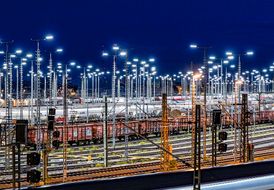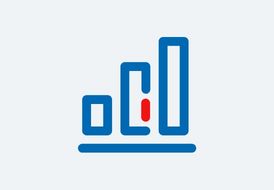Development in the year under review
- Continuing effects of the Covid-19 pandemic, floods and a wage dispute with the GDL had a negative effect on demand.
- Operating profit figures improved.
DB REGIONAL | 2021 | 2020 | Change | 2019 | ||
absolute | % | |||||
Punctuality (rail) (%) | 94.3 | 95.6 | –1.3 | – | 94.3 | |
Punctuality (bus) (%) | 83.9 | 83.4 | +0.5 | – | 81.6 | |
Customer satisfaction (rail) (SI) | 71.6 | 69.0 | +2.6 | – | 66.1 | |
Customer satisfaction (bus) 1) (SI) | 75 | 71 | +4 | – | 73 | |
Passengers (million) | 1,540 | 1,604 | –64 | –4.0 | 2,507 | |
thereof rail | 1,121 | 1,215 | –94 | –7.7 | 1,972 | |
Volume sold (million pkm) | 25,921 | 28,048 | –2,127 | –7.6 | 47,908 | |
thereof rail | 21,407 | 23,897 | –2,490 | –10.4 | 41,633 | |
Volume produced (rail) (million train-path km) | 426.7 | 424.8 | +1.9 | +0.4 | 452.5 | |
Volume produced (bus) (million bus km) | 482.8 | 456.7 | +26.1 | +5.7 | 479.8 | |
Total revenues (€ million) | 8,043 | 7,662 | +381 | +5.0 | 8,945 | |
External revenues (€ million) | 7,929 | 7,553 | +376 | +5.0 | 8,830 | |
Rail concession fees (€ million) | 5,824 | 5,292 | +532 | +10.1 | 5,627 | |
EBITDA adjusted (€ million) | 218 | 184 | +34 | +18.5 | 1,056 | |
EBIT adjusted (€ million) | –417 | –451 | +34 | –7.5 | 408 | |
Gross capital expenditures (€ million) | 480 | 434 | +46 | +10.6 | 560 | |
Employees as of Dec 31 (FTE) | 37,220 | 37,159 | +61 | +0.2 | 36,374 | |
Annual average employees (FTE) | 37,337 | 36,945 | +392 | +1.1 | 36,285 | |
Employee satisfaction (SI) | – | 3.8 | – | – | ‒ | |
Share of women as of Dec 31 (%) | 17.0 | 16.9 | +0.1 | – | 16.8 | |
Specific final energy consumption (rail) compared to 2006 (based on pkm) (%) | +26.3 | +13.2 | +13.1 | – | –30.0 | |
Specific final energy consumption (bus) compared to 2006 (based on bus km) (%) | –2.5 | –1.4 | –1.1 | – | +1.7 | |
1) Change in method from 2020 onwards.
Punctuality did not see a repeat of its level in the previous year, which was characterized by the impact of the Covid-19 pandemic; it was at the same level as in 2019. This was driven by a return to higher utilization of the rail network and the operational impact of high construction volumes. Extreme weather events (mainly a harsh winter, storms and floods) and the wage dispute with the GDL also had negative effects. For these reasons, punctuality fell significantly in the second half of 2021 after a strong first half of the year. The implementation of a number of regional improvement measures had a positive effect. The punctuality of Regional Bus improved.
About 26,000 customers (rail) and about 2,300 customers (bus) were surveyed in two waves for the annual customer satisfaction survey:
- Overall passenger satisfaction with DB Regional Rail increased. The satisfaction figures for regional transport (73 SI) and S-Bahn (metro) (70 SI) improved. Satisfaction with the most recent journey remained unchanged at 79 SI for DB Regional Rail (regional transport and S-Bahn (metro)). Significant improvements were achieved in all performance dimensions.
- Customer satisfaction with bus transport improved significantly, both in terms of satisfaction with the bus company (75 SI) and with the current journey (78 SI).
The performance development differed between rail and bus transport, although it should be noted that the first quarter of 2020 was not significantly impacted by the effects of the Covid-19 pandemic:
- The number of passengers and volume sold in rail transport fell significantly as a result of the Covid-19 pandemic.The extension of the measures to contain the Covid-19 pandemic led to a significant decline, particularly in early 2021. As the measures were increasingly lifted, increases in demand were again recorded from April 2021 onward. There were also negative effects from the floods and the wage dispute with the GDL.
- Covid-19 effects also had a significant negative impact on demand for bus transport, particularly at the beginning of 2021. Overall, however, demand increased as a result of a higher volume produced.
From a financial perspective, DB Regional remained under pressure, although operating profit figures improved slightly.
The decline in passenger numbers did not fully feed through to revenue development. Because of the higher share of gross contracts, revenue risk predominantly lies with the contracting organizations:
- The increase in revenues was primarily due to higher concession fees in rail transport, which more than compensated for the decreased revenues from fares (resulting in part from a change in the Munich S-Bahn (metro) contract from a net contract to a gross contract) and from performance gains in bus transport.
- This was counteracted by a decline in other operating income (–4.5%/€ –43 million), largely caused by a decrease in Covid-19 support payments due to lower Covid-19-related losses than in the previous year.
On the expenses side, there were additional pressures primarily from increases in the cost of materials and personnel expenses resulting from increases in prices and collective bargaining agreements:
- Cost of materials rose (+5.0%/€ +268 million), largely as a result of increases in costs for the use of infrastructure and for energy in rail transport, as well as higher maintenance expenses.
- Personnel expenses increased (+4.1%/€ +89 million), largely as a result of collective bargaining agreements.
- Depreciation remained unchanged overall.
In contrast, the decline in other operating expenses had a dampening effect:
- Other operating expenses decreased (–5.0%/€ –46 million), mainly due to smaller effects from the revaluation of provisions for impending losses.
Capital expenditures increased, primarily as a result of tender-related vehicle purchases.
The number of employees as of December 31, 2021 was at the same level as in the previous year.
The share of women increased slightly.
The specific final energy consumption in rail transport remained above the level of the reference year, 2006, as a result of ongoing Covid-19 effects. The increase in volume produced led to a further increase of this figure in 2021. Nonetheless, the energy efficiency of diesel vehicles improved thanks to the further rollout of the RESY telematics system. This has reduced the energy consumption of the vehicles by up to 10%. In bus transport, specific final energy consumption improved further.
- The Covid-19 pandemic has continued to have an impact on the development of the business.
- There were additional negative effects from floods and the wage dispute with the GDL.
- Development of profits was impacted by price effects.
| RAIL LINE OF BUSINESS | 2021 | 2020 | Change | 2019 | ||
absolute | % | |||||
Passengers (million) | 1,121 | 1,241 | –120 | –9.7 | 2,010 | |
thereof rail | 1,121 | 1,215 | –94 | –7.7 | 1,972 | |
Volume sold (million pkm) | 21,407 | 24,298 | –2,891 | –11.9 | 42,204 | |
thereof rail | 21,407 | 23,897 | –2,490 | –10.4 | 41,633 | |
Volume produced (million train-path km) | 426.7 | 424.8 | +1.9 | +0.4 | 452.5 | |
Total revenues (€ million) | 6,965 | 6,696 | +269 | +4.0 | 7,848 | |
External revenues (€ million) | 6,859 | 6,593 | +266 | +4.0 | 7,740 | |
Rail concession fees (€ million) | 5,824 | 5,293 | +531 | +10.0 | 5,626 | |
EBITDA adjusted (€ million) | 308 | 342 | –34 | –9.9 | 1,037 | |
EBIT adjusted (€ million) | –247 | –226 | –21 | +9.3 | 454 | |
Gross capital expenditures (€ million) | 341 | 329 | +12 | +3.6 | 496 | |
Employees as of Dec 31 (FTE) | 27,737 | 28,090 | –353 | –1.3 | 27,715 | |
Since 2021, the bus transport activities of Regionalverkehr Alb-Bodensee GmbH (RAB) have been reported under the bus line of business. This has resulted in immaterial limitations in the comparability of the previous year’s figures (RAB effect).
Overall, the development of performance in the rail line of business declined. In addition to restrictions resulting from floods and the wage dispute with the GDL, Covid-19-related declines had an effect in early 2021 in particular, as the corresponding months in the previous year had not been impacted by the Covid-19 pandemic. The number of passengers and volume sold recorded significant declines as a result. These have improved again since April 2021. Volume produced remained fairly stable.
Overall, operating profit figures declined. Adjusted for the RAB effect, the decline was even greater. The weak performance had a dampening effect on income development:
- Driven by higher concession fees, revenues rose despite the lower revenues from fares due to Covid-19. As well as general increases from the contracting organizations, revenues were also affected by a change in the Munich S-Bahn (metro) contract. In contrast, the wage dispute with the GDL and the effects of the floods had a dampening effect.
- Other operating income fell, largely due to fewer Covid-19 support payments under the industry solution for local public transportµ 46 owing to lower Covid-19 losses than in the previous year. This was partly offset, primarily by a greater utilization of provisions for impending losses.
On the expense side, there were additional negative effects primarily from price effects and additional expenses for maintenance:
- Cost of materials increased, mainly as a result of higher costs for energy and the use of train-paths and stations. Higher maintenance expenses also had a negative effect.
- Personnel expenses rose, largely as a result of collective bargaining agreements.
In contrast, the decline in other expense items had a dampening effect:
- Declines in other operating expenses mainly resulted from significantly smaller effects from the revaluation of provisions for impending losses. These expenses were unusually high in 2020 due to the Covid-19 pandemic. This effect was partly counteracted by higher expenses for intra-Group services.
- Depreciation decreased, largely as a result of vehicles reaching the end of their useful life.
Capital expenditure activities increased slightly in connection with awarded transport contracts.
The number of employees fell slightly. Adjusted for the RAB effect, there was a slight increase as a result of new operations.
- Revenue losses related to the Covid-19 pandemic.
- Integration of RAB’s bus transport activities.
| BUS LINE OF BUSINESS | 2021 | 2020 | Change | 2019 | ||
absolute | % | |||||
Passengers (million) | 418.9 | 363.0 | +55.9 | +15.4 | 496.8 | |
Volume sold (million pkm) | 4,515 | 3,750 | +765 | +20.4 | 5,704 | |
Volume produced (million bus km) | 482.8 | 429.1 | +53.7 | +12.5 | 452.8 | |
Total revenues (€ million) | 1,191 | 1,042 | +149 | +14.3 | 1,162 | |
External revenues (€ million) | 1,069 | 960 | +109 | +11.4 | 1,090 | |
EBITDA adjusted (€ million) | –91 | –158 | +67 | –42.4 | 20 | |
EBIT adjusted (€ million) | –170 | –226 | +56 | –24.8 | –46 | |
Gross capital expenditures (€ million) | 139 | 106 | +33 | +31.1 | 64 | |
Employees as of Dec 31 (FTE) | 9,483 | 9,069 | +414 | +4.6 | 8,659 | |
Since 2021, the bus transport activities of Regionalverkehr Alb-Bodensee GmbH (RAB) have been reported under the bus line of business. This resulted in limitations in the comparability of the previous year’s figures (RAB effect).
The performance development in the bus line of business increased. In 2021, Covid-19-related declines in the first few months of the year, which were not impacted by Covid-19 effects in 2020, were more than offset by the RAB effect and increases in volumes.
Operating profit figures also improved. However, the economic situation remains challenging.
The positive trend in volumes had an effect on income:
- Revenues increased mainly for performance-related reasons.
- Other operating income increased significantly, largely due to the utilization of provisions for impending losses.
There were additional negative effects on the expense side, mainly from the cost of materials and personnel expenses:
- The increase in the cost of materials resulted mainly from increased procurement of transport services for volume-related reasons and from the rise in diesel prices.
- Personnel expenses increased due to the higher average number of employees and due to collective bargaining agreements.
- The increase in depreciation resulted from capital expenditures in the previous year.
- Other operating expenses increased. Adjusted for the RAB effect, they decreased as a result of lower additions to provisions for impending losses.
Capital expenditure activities increased, particularly in connection with awarded transport contracts.
The number of employees increased, largely due to the RAB effect.



